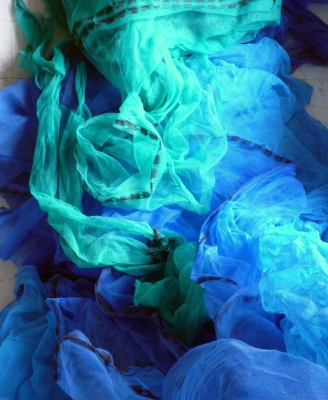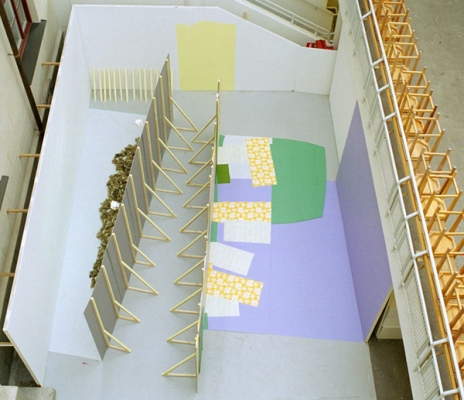Ultimate Painting
Ultimate Painting - En vanlig förväntning på utövare av mixed martial arts (MMA) är att deras matcher ska alstra så autentiska konfrontationer som möjligt. På arenorna utövas inte en viss teknik, här presenteras istället en hybrid av olika kampsporter. Till publikens hänförelse drabbar motståndarna samman i det som går under parollen Ultimate Fighting – as real as it gets.Andréa Hösel lämnar ateljédörren på glänt. På så vis låter hon det konstnärliga arbetet stå i direkt relation till världen utanför; liksom hon själv vandrar ut i staden, tillåts staden flyta in och ta plats i ateljén. Konsten uppenbarar sig överallt. I vardagsrytmens ögonvrå väller färgfält över husfader, ofrivilliga skulpturer trängs bland bråte på byggarbetsplatser, plötsliga färgkombinationer gäckar i grovsoprummet.På studio44 presenteras en platsspecifik rumsinstallation där tre separata verk spänner över väggar, golv och tak. Utställningen består av upphittat material från året som gått: industrinät, sopsäckar, bordsplast, spillror av en vävstol och en spjälsäng, ett täcke. Med lätt hand transformerar hon detta vardagliga material till nya temporära kompositioner. Gallerirummet blir till en canvas, ett skissblock, en palett att träda in och röra sig fritt i. Hösels konstnärskap präglas av motpoler i dynamiska växelspel. Att ge sig hän åt slumpens nycker varvas med den totala koncentrationens nördiga precision. Det abstrakta måleriets begär efter att låta en bild vara en bild, en form vara en form, appliceras på triviala, konkreta objekt som ofrånkomligen bär med sig sin inherenta historia, plats, funktion. En vanlig förväntning på utövare av mixed media art, är att deras verk ska röra sig i svårdefinierade gränsland, där skiljelinjen mellan olika tekniker och medium suddas ut. För Andréa Hösel är det enklare än så. Hon låter måleri, skulptur, textil, grafik och installation drabba samman i det som för henne är det ultimata sättet att måla på. Ultimate Painting - as real as it gets.Andréa Hösel bor och är verksam i Stockholm, där hon även utbildade sig vid Kungliga Konsthögskolan. Utöver tidigare utställningar på studio44 har hennes verk även visats på bl.a. Konstnärshuset, Alma Löv Museum, Marabouparken och A.I.R.Gallery i Brooklyn. – Henning Rehnström augusti 2019
Statement by Mira Dayal
Andréa Hösel's practice is based on iterations – of form, color, and line, but also of materials and processes. Repetition is perhaps inherent to printmaking, but for Hösel the same concepts of creation and deconstruction extend from installations to paintings, her central medium. In recent work she has painted a dance diagram onto a wall, rendering it impossible to use on a vertical surface; destroyed and recycled past work for a new installation concerning the artist's studio; and collected garbage from the street to create an organic, spiraling fabric sculpture. These and other works by Hösel tend toward the abstract but incorporate found and domestic materials, such as telephones, furniture, clothing, or the exhibition space itself. Referencing the labor and duration of artmaking, the works emphasize the time it took to collect their materials, the histories and purposes of the found objects themselves, and the process of conversion from household item to artwork. Fabric – as a material and as a concept – is one element that holds together these works that seem to be discrete, so that a print may be transferred onto a sewn furniture cover, which could then be translated into wallpaper. Hösel's use of color further underpins each work without diverting attention from the formal properties of each medium. For example, in using a colored window screen to shift the atmosphere of a sculptural space and its components, Hösel uses color to deconstruct and reconstruct perception itself with the quotidian structure of a window as well as light, the medium of perception. Perhaps a final, significant unifying element is the inclusion of chance into the artistic process; interactions of light, color, and form influence the course of each work as it develops. In her most recent work, Hösel digs further into rhythms of color as well as of the body. Sleeping, a natural, iterative process, casts the body in both physical and metaphorical shadows. In Hösel's work, this psychological space is represented by the traces of sleep: insomnia, daydreams, and nightmares melt into the upholstery of a couch or looming heaps of blankets, the pattern of each nearly overwhelming its figurative aspects. The paintings do not reach a visual harmony. Rather, in their number and forms, they signify the ongoing mechanics of the painter herself. —Mira Dayal
Statement by Elin Nystrand von Unge
Med vardagliga föremål på sin palett arbetar Andréa Hösel med ett platsspecifikt måleri. I hennes installationer agerar det materiella som minsta gemensamma nämnare – en färg kan till exempel bära med sig en rumslig representation i form av ett föremål, en yta eller ett mellanrum. Men minst lika viktig är tingens och platsens känslomässiga associationsfält. I Hösel´s bildvärld har dessa nämligen flerdimensionella funktioner som färgtoner, volymer eller budskap. Genom sina rumsliga bildvärldar skapar hon ett helt eget konstnärligt språk där gränsen mellan måleri, skulptur och vardagens föremål och miljöer tillåts vara flytande. Också betraktaren bjuds in som medskapare eftersom denna kan röra sig igenom verken och därmed hitta sin egen fysiska och mentala betraktelsepunkt. (With everyday objects on her palette Andréa Hösel work with site-specific painting. In her installations the material act as the lowest common denominator - a paint can for example carry a spatial representation in form of an object, a surface or a space form. The objects themself are equally important and so are the site's emotional association fields. In Hösel's imagery these have multidimensional features: color tones, volumes or messages. Through their spatial imagery she creates an artistic language where the boundary between painting, sculpture, everyday objects and environments are allowed to be fluent. Also, the viewer is invited as a co-creator since he/she can move through the works and thus find their own physical and mental viewpoint.) – Elin Nystrand von Unge


